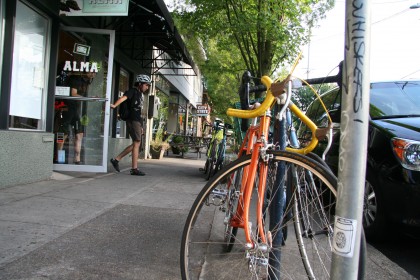
and pleasant for humans in part because
it was developed as a streetcar suburb in the 1910s.
(Photo: M. Andersen/BikePortland)
One of the big annoyances of getting around Portland’s inner east side by bike is the shortage of good ways to get north or south. A project that could become Portland’s best such link (and might thereby improve the route for driving, too) is about to kick off.
The project won’t reach its full design for a year, but it already has a few detractors, and there are a few significant hurdles on the horizon. After a reader tipped us off about neighbors who are concerned about how the project will impact parking and auto access, we figured it was time to check in and bring you up to speed.
The 9.1-mile 20s Bikeway Project is one of the centerpieces of the Bicycle Master Plan passed in 2009. Right now, it’s mostly just a line on a map, a federal grant for $2.5 million, and a target completion date of 2015.
The route connects Northeast Lombard Street to the north and the Springwater Corridor to the south, running directly through many of Portland’s fastest-growing neighborhoods, plus Reed College, Concordia University, Grant and Cleveland High Schools and two major grocery stores. It’s already a very popular bike route due to the lack of alternatives, but it’s not much fun for most people to use that way:
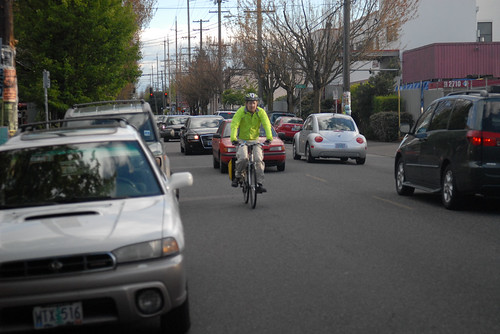
it lacks dedicated space for cycling and is uncomfortable for less confident riders.
(Photo © J. Maus/BikePortland)
City Project Manager Rich Newlands said Tuesday that the route might be tweaked, but that the bikeway is too important to do without. He’s halfway through collecting traffic counts on the corridor.
“Clearly, for it to be a high-quality bikeway, we’re going to need to make improvements to enhance safety for cyclists,” Newlands said.
The grant will improve the bike crossings of Interstate 84 at both 28th and 21st Avenues, which are arguably the best two such crossings in the city. But the main 20s route, Newlands said, will run over the 28th Avenue bridge.
Just north of that bridge and south of Broadway, there’s a particularly difficult corner — a blind turn for northbound traffic that can hide a person on a bike from someone in a car:
Further south, between Sandy Boulevard and Stark Street, is one of the east side’s liveliest commercial districts, with crowded, city-sponsored auto parking on both sides of the street and two lanes of shared traffic that often back up along 28th Avenue.
Between Southeast Division and Taggert, there’s another popular commercial district, and another notable lack of bike lanes:
More sticking points might emerge. At the southern end of the route, some people from the Eastmoreland Neighborhood Association (notably the group’s president Robert McCullough, who sat on the committee behind the City Club of Portland’s recent report endorsing Portland biking and was one of two members to endorse the “minority report” calling for bike licensing) are worried about traffic safety and loss of publicly provided auto parking.
In a post on the Eastmoreland Neighborhood Association Facebook page, McCullough wrote that his neighborhood’s representation on the project’s advisory committee should not be considered a “fait accompli” in terms of their support. “Although Eastmoreland residents have bicycles,” wrote McCullough, “the average age is above 50 and increasing four months each year. This makes the area car rather than bicycle centric (bicyclists tend to be you white males in their 20s). Obviously, “calming” access to the west would make many residents unhappy. It might also slow police and fire response coming from the west.”
Newlands said he expects the solutions to all these problems are likely to include a combination of striped bike lanes, neighborhood greenway style sharrows and speed bumps on low-traffic streets, and possibly separated cycle tracks on the busiest stretches.
Newlands says he’s currently recruiting stakeholders to join a committee that will meet for four to six months starting in October, aiming to finish next year with a plan endorsed by neighborhood and business associations. This would let the bikeway be completed by 2015.
“I’m mildly confident that it’ll be a sufficient amount of money that we’ll be able to do what we need to do,” Newlands said. “But, again, it all depends on what kind of issues we find during the plan process.”


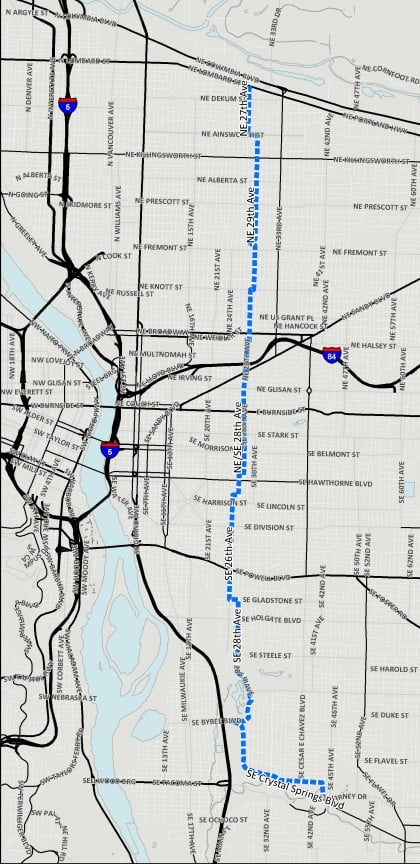
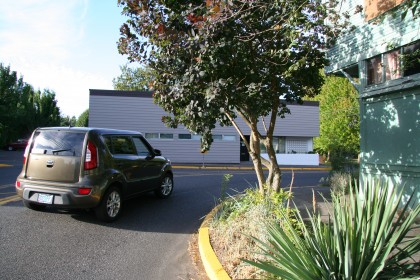
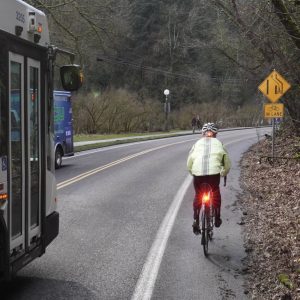
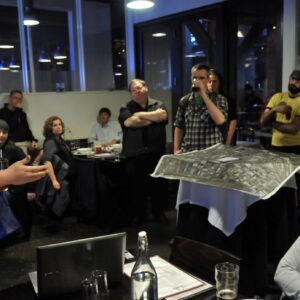
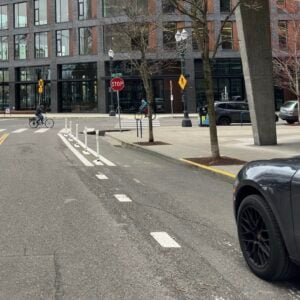
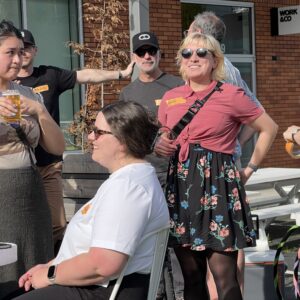
Thanks for reading.
BikePortland has served this community with independent community journalism since 2005. We rely on subscriptions from readers like you to survive. Your financial support is vital in keeping this valuable resource alive and well.
Please subscribe today to strengthen and expand our work.
SW 37th from Crystal Springs Blvd could be a better route to Springwater Corridor. But it is partly graveled just before entrance of the corridor and is also extremely steep right at the path in the corridor. I think both could be fixed. Anyway I am looking to see it happen. I live in Milwaukie.
It’s in the 2030 plan as a greenway connection also. Seems like a good location for a shared path to the trail. A green street design might garner BES funding for innovation.
By far the most integral stretch of this bike-way is 28th between Glisan and Stark. All else fails without this. Sharrows simply will not do here as traffic, both car and bike, is regular throughout the day. It will be a painful transition if decided, but I can see no alternative to removing parking on one side of the street. With the two bike corrals already on the East side of the street, likely the west side parking will go from Glisan to Burnside. Whether or not residents and businesses will allow this is anyone’s guess.
Might this be the first important eastside commercial corridor to have decent bike access? It has to happen somewhere, eventually.
It would actually be the second. Williams Ave has dedicated space for bicycling and it’s also a commercial corridor.
It has to happen. I see conflicts here nearly every time I drive or ride through. Impatient motorists, not enough room. We need to stop sacrificing safety in the public ROW for private vehicle storage.
I’m sick of being a passenger in a car on this stretch and hearing a driver say, “does that cyclist HAVE TO use this street?” to which I reply, “do you?” They’re both vehicles and they’re both accessing businesses on this route. Chill the hell out for a few short blocks.
yes, yes, YES.
Removing parking on only one side of the street simply won’t provide enough ROW for anything but substandard bike lanes, similar to the ones already on SE 26th between SE Clinton and SE Gladstone.
How about another option… No passing zones and signs/markings that make it clear “Cars are guests”. That’s what I saw in Rotterdam. Worked like a charm.
I think we ought to recognize that an idea like this, or installing bicycle advisory lanes, on 28th won’t work without some serious auto diversion. The car volumes on that street are just too great.
An installation (not just an idea!) like that *is* a serious auto diversion.
I ride like all the neighborhood greenways are no passing zones. If someone wants to pass me they can take a left and use Prescott instead.
Generally I don’t like the idea of removing on-street parking, but in this case I think it may be a good idea. 28th Street retail (which depends on curbside parking) generally occurs on the east side of the street. Removing parking should not be a deal killer.
I am familiar with 28th between Fremont and Division, less familiar with the parts further north or further south.
In general, I think many or most parts of this street are not wide enough to accomodate north and south separated cycle tracks or buffered bike lanes, and in many portions it would be difficult to fit even standard bike lanes in the door zone.
In a few particularly dangerous spots, parking can be removed and a buffered bike lane created. I don’t think it is politically feasible, commercially sensible, or equitable to the residential neighborhoods, to eliminate most of the street parking on 28th.
For most of the road, I think the focus will have to be on making drivers slow down, drive more safely, and ultimately choose a different north-south route. Cars have many equally good north-south routes in this part of Portland (11th/12th, 20th, 33rd, 39th, etc); bicycles should have at least one.
That suggests a lot of traffic calming, traffic diversion, lower speed limits, more traffic signals synchronized to that lower speed, signage and markings, enforcement and outreach. Perhaps there can be median barriers on a few of the major east-west streets that 28th crosses (e.g. Burnside, Glisan), that cyclists can go through but that would make the route inconvenient for drivers.
The thing about the residents around 28th is that they benefit from the increased property values and general awesomeness of living there due to the commercial area, so I don’t really feel for them when they also have to deal with some of the downsides of it.
Of all the places I lived Portland has the most entitlement around street parking. Use your driveway, or support permitted parking in your neighborhood, or support more bike friendly infrastructure so less people drive to 28th in the first place!
Amen. So many want to live “in the city” but don’t want any of the drawback of living “in the city”. I don’t have a lot of pity on people who don’t park in their own driveway or converted their garage to a rental apartment.
20’s bikeway is a bit ambiguous, since there are two of them in the 2030 plan. The low 20’s, 22nd Avenue Greenway – Lombard to Ankeny, and the high 20’s, the 26th/27th/28th/29th route of this story.
Good catch. You’re correct about the route. I’m using the city’s official name for the project.
This proposed route connects so many things that need to be connected, I’m giddy with anticipation, but also wary that one of the more essential sections, through the business district on either side of Burnside, will be watered down. As a Reed College grad proud of my alma mater’s high academic standards, counterculture ethic, and affinity for essential oils, I propose the section from Hawthorne to Woodstock be named the Patchouli Highway.
“I can see no alternative to removing parking on one side of the street. With the two bike corrals already on the East side of the street, likely the west side parking will go from Glisan to Burnside.”
I think most of the businesses are on the east side of the street, especially between Burnside and Glisan. Would that suggest greater need for parking on the east side?
The beauty of a “complete streets” approach is that it wouldn’t be that big a deal to actually, you know, cross the street. Also, I think which side of the street you park on has a lot more to do with which direction you were coming from than with which business you want to visit.
If you are losing customers because they have to cross the street, you probably won’t last long in Portland. Time to move to a shopping mall in Gresham…
Geez, crossing a 30-foot wide street is such a travesty!
All kidding aside, I used to live ON 28th, and it is already THE major N-S bike corridor. It illustrates well what happens when you just let cars & bikes mix w/out infrastructure. Typically it ends up being a leap-frog of cars & bikes passing each other. If we are thinking about bike lanes, they need to be wide.
olo – not sure how’d you’d fix that 37th street path onto Springwater. It would require a lot of excavation. Plus in the current set up you’d still have access to that path from the existing plan, it’d just still be unimproved and hilly, though some signage announcing the hill and intersection might be in order because I can see traffic down this path increasing due to this route.
Though I do wonder if instead of the current jog on 28th if Kroger (ie Fred Meyers) could be convinced to ditch some of that parking on the West end of their lot for a cycle track that spilled out onto 28th near NE Wasco where there is already a marked crosswalk. After all, of all the Portland businesses that might “get it” as far a bikes goes around here it would be Fred Meyers (look at the Hawthorn racks any given day, same with the less extensive Foster store racks which is often full). I’d think they might be interested in having hundreds of daily riders passing by, in exchange for a few less than ideal parking spots.
You’d still have a jog going the opposite direction, but it might be a decent option if done right.
As a longtime resident of inner NE, I’d be thrilled with *any* consistent, connected, safe(r) way south, even if it meant routing bikes one block east or west of the main business district around Burnside-Glisan. I don’t see how PBOT could sell reduced parking in that zone and I don’t want to ride in traffic there–sharrows would NOT do for me. A safe way across the Banfield and Sandy would trump the slight inconvenience of going around the block to get to one of the shops or restaurants on 28th.
If you’re right and car-parking removal on 28th between Stark and Glisan is not in the cards, I hope PBOT pays serious attention to the arterial crossings on the alternate route. Crossing Burnside and Sandy with no help would be no good, and even Stark and Glisan would need crossing treatments to be truly welcoming. I’m tired of some of Portland’s “greenways” that dump you at crossings of high-traffic streets with an implicit “good luck getting across here, sucker!”
In other words, don’t do anything until you can do everything? I know that that Portland looks like.
No, I want them to do more projects, just do them right! I understand that when PBOT was putting in the very first bike boulevards (e.g. the inner-inner southeast), they didn’t know how much infrastructure to put in, and didn’t want to rock the auto-dominated boat too much. But we should be past that now. We know that most greenways need some auto diversion to be comfortable facilities. We know that greenways need some sort of treatment (even if “just” marked crosswalks or a mini-center-turn-lane for bikes) at every major street.
PBOT should be budgeting enough funds and political capital when planning a greenway project to make it happen with all the changes that are necessary for it to be a big success and welcoming to a wide variety of Portlanders, including seniors and kids on their own bikes.
there’s not enough money to do all Portland wants to do.
Anyone want to identify business along SE 28th that don’t support removing parking from one side of the street to accommodate bikes? A boycott against those businesses might convince them that more bikes equals more business.
28th between Stark and I-84 really should have some kind of dedicated bike lane. Bikers have to use the road, and that slows down traffic for everyone.
One side is not enough.
Most those businesses on 28th are local taverns, bars,cafes and restaurants. Many of which already get many riders as patrons. I’d think most of them would support a few less parking spaces on the street for more traffic of any kind.
Especially bikes where the people going by are likely thirsty, and more prone to just stop and look around (as long as ample bike parking is available), get a drink, grab a snack etc… than someone passing in a car that even with on street parking is more of a hassle than it might be worth to the driver.
Don’t underestimate the power of inertia. Commercial real estate is still marketed partly on the basis of number of passing motorists. And likely is what drew some shop owners to these strips. Anything which may make car driving less desirable is seen as the end of the world to these people.
I actually know some old people who are almost pathologically obsessed with finding stores and neighborhoods with “good parking”. I anticipate a knee-jerk reaction to any proposal which eliminates parallel parking.
@gutterbunnybikes – I bet most of them do, but some of them must not because they are the only people I can think of that would fight removing parking. Maybe I said it too negatively, I guess I also meant that then we could support businesses that DO support biking.
@kittens – exactly.
I’m willing to bet the residential properties that are on the strip will protest more than the businesses. Especially the apartment buildings.
Have you asked them?
Not only that, but academic research has proven that people on bikes spend more, more often at those type of establishments than customers who arrive by car.
I’m all for the “bikes mean business” argument, but let’s be careful and conservative about how we discuss it. Bicyclists do not spend more, more often. Bikes spend less per trip, but visit more, to spend more overall, at certain types of retail (restaurants, bars and convenience stores). [http://bikeportland.org/2012/07/06/study-shows-biking-customers-spend-more-74357]
As luck would have it, that core commercial segment on NE 28th has a lot of bars and restaurants, so the argument should go over well with neighborhood business owners. But I would hate to give them superlative information and have them find out about the details later. Maybe a PSU student group could do a capstone project replicating a similar survey just for the 28th Avenue corridor to help illuminate the point.
If the average age in Eastmoreland is above 50 and increasing, wouldn’t it make sense for the neighborhood to be safer to walk in? Most people I know who are nearing retirement are planning their living situations around the fact that walking (or maybe riding a trike) is likely to be their only option for independent travel at some point in the future. I wonder which will be more pleasant for grandparents to walk near: people on bikes riding at 10-15 MPH, or people bombing around neighborhoods in cars traveling 35-40 MPH (or regularly faster in some areas)?
Nope. Everyone should continue driving until they become so old that they crash and injure or kill someone. Then we MIGHT consider taking their license away.
“Drive until you die” – it beats expiring on your deathbed!
I wrote to the project director:
28th is a route we often need to take, especially between NE Broadway and SE Stark, where there are no alternate routes for 1.5 to 2 miles to the east (47th) or west (12th). This is the critical section of this bikeway.
The two options are: 1) Divert car traffic off 28th between Sandy and Stark, and slow 85%car speeds to 15 mph, or 2) Separate bike and car traffic. Sharrows alone won’t work with the current speeds and traffic, as we experienced when trying to ride on the street once with a group of kids and families.
The rest of the route looks good, except at the ends. On the north, there is a clear lack options to continue north to Marine Driver or Vancouver. The budget won’t be big enough in this project, but there eventually needs to be an acceptable way to cross Lombard and Columbia. The current viaduct on 33rd is hair-raising or terrifying in either direction.
On the south end, it is quite a detour east to 45th or west to Hwy 99 to continue sout to Clackamas county. There is a short but steep path to the Springwater trail at 37th. Could a couple of switchbacks be added to this path as part of the project, to make it usable in the uphill direction?
Even better would be a route from 27th thru or around Eastmoreland golf course, to Tenino and Tacoma, and eventually 32nd. Since the city owns the golf course (right?), it would make sense to provide a path that would be more direct.
“Sharrows alone won’t work with the current speeds and traffic, as we experienced when trying to ride on the street once with a group of kids and families.”
How do you know sharrows won’t work? There aren’t any there now; the only way to know is to at least test them.
Better yet, install sharrows now, so they provide some benefit to the large number of cyclists already using this route, then replace them with whatever this design team comes up with sometime in the future.
As it stands now, there’s absolutely nothing informing motorists to expect cyclists on this route, and I’m guessing that it’s at least 5 to 10 years before anything new actually gets built as a result of this process.
Well, Sharrows will work here just as well as they work on the St Johns Bridge or the Oregon City bridge: they might stop drivers from honking or shouting at you, but they won’t make the street feel safe for slower or less confident bike riders.
I take the lane on those bridges, and on 28th, with confidence. Would you be comfortable taking your non-cyclist parents, or grandparents, down 28th? How old would a kid need to be to ride on that street right now?
Sharrows are not an alternative to slower car speeds and lower car traffic volumes.
if more cyclists use 28th due to intersection redesign and prominent placement of sharrows a safety in number phenomenon is a virtual certainty. moreover, the explosive growth of bike traffic on heavily used sharrowed routes in san francisco provides a terrific example of the utility of this type of infrastructure. i am still furious that pbot used the sharrow for wayfinding on our craptastic bike boulevards.
Re: “I’m guessing that it’s at least 5 to 10 years before anything new actually gets built”
There is a federal grant for $2.5 million, and a target completion date of 2015, according to the article.
They picked a steep way up Alameda, I think. More direct but 27th to Ridgewood to Regents is more gradual. I hope this project includes some repaving because 29th north of Prescott is pretty miserable to ride on. And I hope they fix the bump on the nb 28th Ave I84 overpass BEFORE 2015.
Agree about Regents being a better, more gradual, route. Maybe they can sign an alternate route.
The bump on the 28th overpass is on both sides of the bridge, but the NB one is worse. The NB one is easy to spot when rain runoff puddles behind it.
Increasingly we are going to have to make more difficult choices to accommodate the expansion of the bike plan. We’ve done the easy part, now we got to do the hard stuff. Does PBOT have the balls?
Generalize much? As a year-round, daily commuter who is 45 years old, I take offense.
You should move to East Moreland with Charlie!
yeah, right? where did the “white 20s male” data come from, and why do they think that won’t change along with their own demographics?
I’m 43 and, like you, my average age is increasing 12 months each year.
And as a 62-year-old year-round daily commuter I too beg to differ.
I was witness to anti-cyclist road-rage on the 28th ave crossing over I84 a couple years ago… grumpy old man in a pickup wanted to kill the rider in front of me… I was able to get the plate # and give it to the rider but not sure if anything came of it…
A few months ago on 28th, my son had someone lean out of a passenger side of a truck, yell at him, and try to shove him off of his bike. My son’s route home spends all of two blocks on 28th (between Couch and Ankeny). And on that day, he had stopped at the light at Burnside. So if you’re scoring at home, one block worth of ‘being on a bicycle’ resulted in road rage.
Does it occur to Mr. McCollough that this 43-year old contractor likes to have safety improvements to better serve his neighborhood. I have several clients in the Eastmoreland/Reed College area. His generalizations of bicyclists is laughable.
Would 28th work as a woonerf? Maybe in the core Ash to Everett section if not for the entire Stark to Glisan stretch.
28th, Broadway to Stark, apart from a collector street, is also a fire response street. No diversion, no regular speed bumps, minimal speed reduction.
I think the Portland fire department’s directives on street design are overly restrictive. They are often a big barrier for biking and walking projects. When they end up requiring greater accommodation of motorized travel and little accommodation for non-motorized travel, I think they cause a net decrease in Portlanders’ well-being.
On the plus side for changing fire department directives:
*Fewer and less serious accidents for emergency responders to treat
*Better health due to more Portlanders biking and walking for transportation
On the minus side:
*A small increase in response times for emergency vehicles.
It seems pretty likely to me that reforming these directives would increase Portlanders’ health and decrease medical and emergency response costs.
The Fire Bureau’s anti-bike positions are an absurd joke. They need to start providing hard data to back up their concerns over their routes being compromised. These projects are about, in part, preventing people from being hit and killed… that is more of an urgent public safety need than the anecdotal potential that response times will be hindered. Also, if the Fire Bureau wants quicker response times, they should use smaller trucks/vans more often instead of those ginormous engines.
3/4 or more of the fire bureau’s calls are not for fires, they’re for medical emergencies. Compare that to the kind of equipment they buy. How different would things look like if we had a ‘Fire Response Team’ and a ‘Medical Emergency Response Team’ instead of Portland Fire and Rescue?
a big fat meh to designation as a “collector street” being any sort of barrier to creating a safer and more livable city.
“It might also slow police and fire response coming from the west.”
This sounds like code for: We don’t like bikes but can’t say that outright so we’re just going to throw as many excuses at the wall and see what sticks.
“worried about traffic safety”
+1
Speed bumps don’t slow police response. Speed bumps have minimal effect on ambulances going to an event (arguably the most important part of the trip). Regular speed bumps slow fire trucks up to 10 seconds for each one. The City is even working on a fire friendly speed bump – speed cushions or offset speed tables, to reduce delay to about 2 seconds. I’ve seen speed cushions on NW Cornell and SW 51st(?).
Many of our commercial streets are simply too small to accomplish balanced transportation needs. Sorry cars, you’re going to have go on a diet and get skinny if you want to stay 🙂
But seriously, these roads should really only have on car lane (one-way), with room for car parking, bike parking, a cycle track on both sides and replace our pathetically skinny sidewalks with wider ones if possible.
I’m 57 years old eastmoreland resident and I ride my bike allot.
When Mr. McCullough writes “Obviously, “calming” access to the west would make many residents unhappy.”
I totally disagree, in 2 years a light rail station will be at the west end of the neighborhood. Does he really want people from east Portland racing through the neighborhood to meet the train on time?